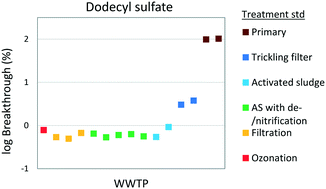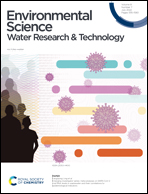Removal of 293 organic compounds in 15 WWTPs studied with non-targeted suspect screening†
Abstract
Understanding how contaminant breakthrough in wastewater treatment plants is influenced by chemical structure and treatment technology is important for protecting the aquatic environment. In order to assess this question, consistent contaminant breakthrough measurements are required for a large number of chemicals. Using direct injection UHPLC-Orbitrap-MS/MS with data-dependent non-target data acquisition followed by suspect screening against a library of >7000 compounds with exact mass and MS2 spectra, we quantified the removal of 293 chemicals in 15 WWTPs with widely varying treatment technology. Principle component analysis showed a clear and consistent influence of treatment technology on contaminant breakthrough. Log breakthrough was significantly correlated with log TSS and log BOD in treated effluent for 71% and 68% of the chemicals, respectively. Chemicals were identified which could be used as indicators of the standard of wastewater treatment. Furthermore, chemicals were identified that could be used to predict the breakthrough of groups of other chemicals. A high degree of correlation was found for the breakthrough of different groups of chemicals, which suggests that the data could be used to develop models describing how chemical structure influences breakthrough or removal efficiency. Non-targeted suspect screening is a useful method for generating consistent WWTP breakthrough data for large numbers of chemicals.

- This article is part of the themed collections: Best Papers of 2022 from RSC’s Environmental Science journals, Recent Open Access Articles and Best Papers 2022 – Environmental Science: Water Research & Technology


 Please wait while we load your content...
Please wait while we load your content...